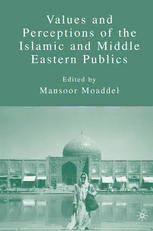
Values and Perceptions of the Islamic and Middle Eastern Publics PDF
Preview Values and Perceptions of the Islamic and Middle Eastern Publics
Values and Perceptions of the Islamic and Middle Eastern Publics This page intentionally left blank Values and Perceptions of the Islamic and Middle Eastern Publics Edited by Mansoor Moaddel VALUESANDPERCEPTIONSOFTHEISLAMICANDMIDDLEEASTERNPUBLICS © Mansoor Moaddel, 2007. Softcover reprint of the hardcover 1st edition 2007 978-1-4039-7527-0 All rights reserved. No part of this book may be used or reproduced in any manner whatsoever without written permission except in the case of brief quotations embodied in critical articles or reviews. First published in 2007 by PALGRAVE MACMILLAN™ 175 Fifth Avenue, New York, N.Y. 10010 and Houndmills, Basingstoke, Hampshire, England RG21 6XS Companies and representatives throughout the world. PALGRAVE MACMILLAN is the global academic imprint of the Palgrave Macmillan division of St. Martin’s Press, LLC and of Palgrave Macmillan Ltd. Macmillan® is a registered trademark in the United States, United Kingdom and other countries. Palgrave is a registered trademark in the European Union and other countries. ISBN 978-0-230-62198-5 ISBN 978-0-230-60333-2 (eBook) DOI 10.1057/9780230603332 Library of Congress Cataloging-in-Publication Data Values and perceptions of the Islamic and Middle Eastern publics / edited by Mansoor Moaddel. p. cm. Includes bibliographical references and index. 1. Arab countries—Social conditions—20th century. 2. Arab countries—Social conditions—21st century. 3. Social values— Arab countries. I. Moaddel, Mansoor. HN766.Z9M683 2007 06.0917(cid:2)67—dc23 2006049325 A catalogue record for this book is available from the British Library. Design by Newgen Imaging Systems (P) Ltd., Chennai, India. First edition: February 2007 10 9 8 7 6 5 4 3 2 1 For Armin, Marjan, Nilufar, and Payvand This page intentionally left blank C O N T E N T S List of Figures ix List of Tables xi Preface xiv List of Contributors xvi 1 Introduction: Theoretical and Methodological Issues in the Study of Values 1 Mansoor Moaddel Part 1 Islam in a Global Perspective 2 The Worldviews of Islamic Publics in Global Perspective 25 Ronald F. Inglehart 3 Value Systems of Elites and Publics in the Mediterranean: Convergence or Divergence 47 Juan Díez-Nicolás 4 Muslim Immigrants in Western Europe: Persisting Value Differences or Value Adaptation? 71 Thorleif Pettersson Part 2 Political and Economic Consequences of Islam versus Rentier Economy 5 Do Islamic Orientations Influence Attitudes toward Democracy in the Arab World? Evidence from the World Values Survey in Egypt, Jordan, Morocco, and Algeria 105 Mark Tessler viii Contents 6 The Egalitarian Face of Islamic Orthodoxy: Support for Islamic Law and Economic Justice in Seven Muslim-Majority Nations 126 Nancy J. Davis and Robert V. Robinson 7 The Rentier State: Does Rentierism Hinder Democracy? The Rentier Mentality Hypothesis Tested in Seven Middle Eastern Countries 160 Bi Puranen and Olof Widenfalk Part 3 Determinants of Self-Rated Health and Attitudes toward Religion, Gender and Democracy 8 Social Structure versus Perception: A Cross-National Comparison of Self-Rated Health in Egypt, Iran, Jordan, and the United States 181 Kristine J. Ajrouch and Mansoor Moaddel 9 The Saudi Public Speaks: Religion, Gender, and Politics 209 Mansoor Moaddel Part 4 Events and Changes in Values and Perceptions 10 Events and Value Change: The Impact of September 11, 2001 on the Worldviews of Egyptians and Moroccans 249 Mansoor Moaddel and Abdul-Hamid Abdul-Latif 11 Xenophobia and In-Group Solidarity in Iraq: A Natural Experiment on the Impact of Insecurity 298 Ronald Inglehart, Mansoor Moaddel, and Mark Tessler Part 5 Methodology 12 Probability Sampling and the Scientific Survey Method for Population Studies: Application to Survey Research in Islamic Countries 323 Steven G. Heeringa Index 339 L I S T O F F I G U R E S 2.1 Cultural map of 82 societies 29 2.2 Cultural zones of 82 societies 31 2.3 The values of Islamic societies in global perspective 33 2.4 Support for democracy in nine cultural zones 41 2.5 Support for Gender Equality in nine cultural zones 43 3.1 Survival/Self-expression values by GNP per capita 53 4.1 Analysis of value change among Muslim immigrants 79 7.1 Intergenerational changes in Survival/ Self-expression values 166 7.2 Intergenerational changes in traditional/secular rational values 166 7.3 The seven Middle East countries on cross-cultural map 167 7.4 Two dimensions of democratic values for the seven countries 171 7.5 Two dimensions of work and social life for the seven countries 173 7.6 Two dimensions of democratic values Saudi Arabia 174 7.7 Two dimensions of work and social life and Saudi Arabia 175 7.8 Inglehart’s cross-cultural map and Saudi Arabia 176 8.1 Path diagram and standardized structural coefficients for Egypt 194 8.2 Path diagram and standardized structural coefficients for Iran 195 8.3 Path diagram and standardized structural coefficients for Jordan 196
